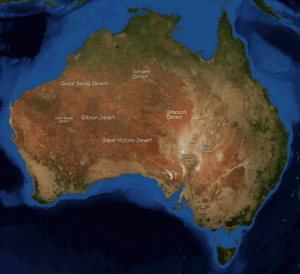Great Sandy Desert facts for kids
The Great Sandy Desert is a huge desert located in the northwest of Australia. Most of it is in Western Australia. It is the second-largest desert in Australia, right after the Great Victoria Desert. This vast area covers about 284,993 square kilometers (110,036 square miles). To its south, you'll find the Gibson Desert, and to its east is the Tanami Desert.
Contents
Who Lives in the Great Sandy Desert?
Not many people live in the Great Sandy Desert. The main groups are Aboriginal communities and towns where people work in mining. The Aboriginal people here belong to two main groups: the Martu people in the west and the Pintupi people in the east. Both groups speak languages from the Western Desert language family.
Climate and Weather
The Great Sandy Desert does not get much rain. Even in the driest parts, rainfall rarely drops below 250 millimeters (10 inches) per year. However, the rate of evaporation is very high, meaning water dries up quickly. Most of the rain comes from powerful thunderstorms. Many dry years often end with a monsoon or a tropical cyclone, which brings more rain. On average, most of the area experiences about 20 to 30 days a year when thunderstorms form.
Plants and Animals
The main type of plant growing across the Great Sandy Desert is spinifex grass. This tough grass is well-suited to the dry conditions. Many interesting animals call this desert home. You can find dingos, red kangaroos, and various types of monitor lizards. Other unique creatures include bilbies, marsupial moles, thorny devils, and bearded dragons. There are also many other species of lizards living here.
Exploring the Desert: Early Journeys
The first European person to cross the Great Sandy Desert was Peter Warburton. He started his journey from Alice Springs in April 1873. He finally arrived at De Grey Station in January 1874. Warburton faced many challenges during his long trip. He credited his survival to his Aboriginal companion, Charley.
See also
 In Spanish: Gran Desierto Arenoso para niños
In Spanish: Gran Desierto Arenoso para niños


